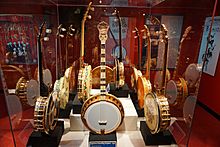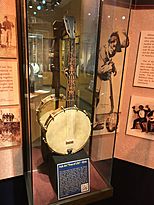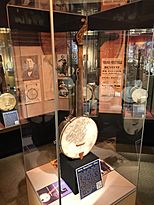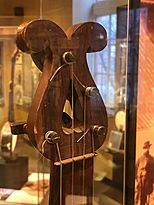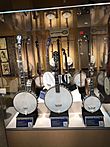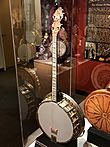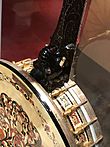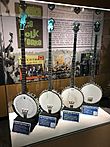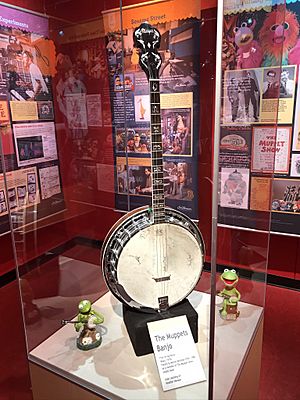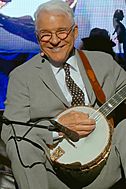American Banjo Museum facts for kids
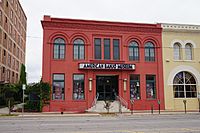
American Banjo Museum
|
|
| Former name | National Four-String Banjo Hall of Fame Museum |
|---|---|
| Established | 1998 |
| Location | 9 East Sheridan Avenue, Oklahoma City |
| Type | Musical instrument museum |
| Collections | banjos |
| Collection size | 400+ instruments |
| Founder |
|
The American Banjo Museum in Oklahoma City is a special place that celebrates the history of the banjo. This museum shows how the banjo came to North America and how it became popular over time. It was started in 1998 in Guthrie, Oklahoma, by Jack Canine and moved to Oklahoma City in 2009.
Contents
Discovering the Banjo Museum
The museum began with two people, Brady Hunt and Jack Canine. They opened the National Four-String Banjo Hall of Fame Museum in Guthrie, Oklahoma, in 1998.
Jack Canine gave over 60 fancy four-string banjos to the museum. Later, in 2007, the museum got a huge collection of 182 "jazz-age" banjos from Europe. This made it one of the biggest banjo collections in the world!
At first, the museum focused on four-string banjos. But by 2013, it started including five-string banjos too. By 2018, the museum had more than 400 instruments. Over 300 of these are on display across two floors. The museum also has old recordings, films, music sheets, and other banjo-related items.
Banjo History and Culture
The Banjo's Journey in America
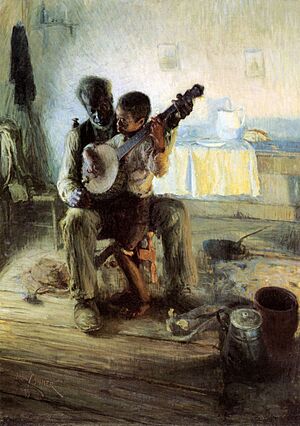
The museum explores about 370 years of banjo history in the United States. It starts from the mid-1600s and comes all the way to today.
One exhibit shows the banjo's beginnings with African-American people. The first American banjos were used for singing and dancing. This was mainly part of Black culture for almost 200 years. This display includes a 3D scene from the famous painting The Banjo Lesson by Henry Ossawa Tanner. It shows an older African-American man teaching a young boy to play.
Another part of the museum shows how the banjo became popular with more people. It moved from African-American culture into mainstream American music. This happened through popular shows and new banjo designs.
After the Civil War, the banjo became popular in homes of middle and upper-class families. Musicians like Vess Ossman even played the banjo in concert halls. They played classical music using a special finger-picking style. The banjo also became a social instrument, with college students forming banjo clubs. It was even seen as acceptable for women to play.
Banjo in the Roaring Twenties
A cool multimedia display talks about the 1920s, the ragtime music era, and dance culture. The banjo was super important then, much like the electric guitar is today! Stars like Eddie Peabody played the banjo.
Ragtime music led to jazz and popular dances like the Charleston. The four-string banjo, played with a pick, helped create the rhythm for these dances.
Banjo in Modern Times
The museum also shows how the banjo stayed popular after World War II. Musicians like Earl Scruggs (bluegrass), Pete Seeger (folk), and Bela Fleck (jazz, rock) kept the banjo alive. They helped it become popular in many different types of music.
Amazing Banjo Instruments
The museum shows banjos that highlight how technology changed over 160 years. You can see rare banjos from famous makers like Epiphone, S.S. Stewart, Gibson, and Les Paul. Modern brands like Deering Banjo Company are also on display. The banjos are arranged by time period on the ground floor.
Banjos from the Minstrel Era (1830s–1870s)
In the 1840s, banjos started to look more modern, moving away from homemade styles. Joel Walker Sweeney, a performer, made the five-string banjo very popular. He encouraged William Boucher to make banjos for him to sell. The museum has a banjo from 1845 made by Boucher. He is known as the first person to sell banjos in the U.S.
The museum also has an 1840s five-string banjo with a peghead shaped like a lyre. Another old banjo from 1854 has a metal body.
Banjos from the Classic Era (1880s–1910s)
By the 1880s, people wanted to make the banjo more fancy. Teachers started teaching a new finger-picking style. Banjo clubs became popular in colleges. The museum has banjos from this time by S.S. Stewart and Fairbanks and Cole.
Banjos from the Jazz Age (1910s–1930s)
When the museum started in 1998, it focused on the four-string banjos from the early 1900s. New music styles led to new kinds of banjos. The four-string plectrum and tenor banjos became popular.
One of the most valuable banjos in the museum is a Gibson RB-7, made in 1938.
Banjos from the Bluegrass and Folk Era
After World War II, it was hard to find banjos. Most banjo makers had stopped making instruments to help with the war. Music tastes changed, and guitars became more popular.
But musicians like Pete Seeger and Earl Scruggs helped bring the banjo back! They are very important at the museum. The museum has banjos related to different parts of Earl Scruggs' career. It has a Gibson "Earl Scruggs Standard" banjo from 1984, which looks like his famous "Granada" banjo. The museum also has two banjos inspired by Scruggs from Vega.
Banjo Hall of Fame
The museum's Hall of Fame also grew to include all types of banjos. In 2013, it started honoring five-string banjo players too.
Some people inducted into the Hall of Fame in 2018 include Bela Fleck (for five-string playing) and Jim Henson (for promoting the banjo). In 2019, Alison Brown (five-string playing) and John Hartford (historical) were honored.
Special Exhibits
Jim Henson and the Banjo
Jim Henson, the creator of the Muppets, was added to the Banjo Hall of Fame in 2018. From September 2018 until 2020, the museum had a special exhibit called "Jim Henson – Life and Legacy." It showed the history of the Muppets.
Henson showed the banjo in a fun way in his shows. Guests on The Muppet Show like Steve Martin played the banjo. This helped many people around the world see and enjoy the banjo.
The exhibit showed Henson's work and included videos of Kermit the Frog playing the banjo. You could see Kermit's first banjo appearance from Sam and Friends. There was also a clip of Kermit playing "Rainbow Connection" in The Muppet Movie.
The Henson family even let the museum display one of the Kermit the Frog Muppets!
A five-string Maya banjo was also on display. This banjo made the sounds for the Muppet banjos! It belonged to Martin Kershaw, who played it on thousands of recordings. His banjo was signed by many famous people like Frank Sinatra and Elton John.
Steve Martin: Banjo Comedian
Comedian and actor Steve Martin had an exhibit in 2015. He was inducted into the Hall of Fame for helping to promote the banjo. Many people today think of Steve Martin when they think of the banjo!
In January 2020, Steve Martin gave a special banjo to the museum. It has gold plating, a picture of Mark Twain on the back, and the Kennedy Center logo on the fingerboard. He received this banjo as part of the Mark Twain Prize for American Humor in 2011. The museum also got a Jazz-Age Gibson Florentine banjo from him. The museum is creating a new exhibit about Steve Martin and his love for the banjo using these instruments.
Images for kids
-
Jazz-Age banjos at the museum. The one in the back is a 1955 Gibson PB-250 banjo, made electric by Les Paul.


